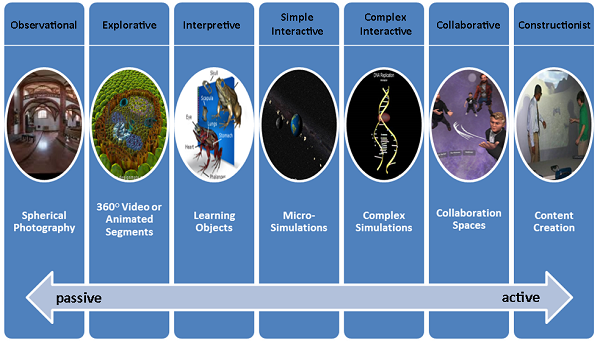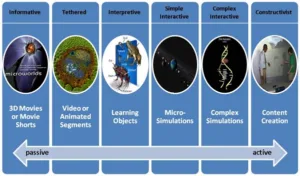In a previous article (Is educational VR content ready for prime time?) I tackled the notion of educational content categories for both 3D and virtual reality. I wrote: “…3D educational content came in a diversity of approaches and design – six flavors, if you will,” adding that “contemporary VR content for the education market today still fits clearly into these same lanes.” See my original thinking in the chart below.

Taxonomy of Educational Stereo 3D Content, Scrogan 2011
Upon further reflection, I knew I was wrong—or at least missing something in my taxonomy. I refined my thinking and developed this new, improved taxonomy, one specific to educational virtual reality content:
 Taxonomy of educational VR content, Scrogan 2016
Taxonomy of educational VR content, Scrogan 2016
In this revised taxonomy, I added a content category for collaborative virtual reality, i.e., the kind that enables participants to meet together, explore together or work together. This kind of involvement transforms virtual reality into a shared rather than a solo experience (a solid example of this genre of virtual reality can be found in the educational company High Fidelity). I also made an attempt to differentiate between spherical photography and 360° video, which dominate the Google Cardboard platform.
With an improved taxonomy in hand, I felt much better. But what didn’t change, in my way of thinking, is the core challenge: nearly all of the educational VR content I have seen to date still slides only into the first three lanes: spherical photography, more passive 360° video or animations, or learning objects (imagine simple walkthroughs, immersive field trips, and objects that can be rotated). Despite their immersiveness in a VR context, these learning opportunities are all passive experiences. Yet hardly any VR content in today’s educational marketplace reaches into the more interactive lanes of micro-simulation, complex simulation, collaboration spaces, and user-generated content. These latter lanes often work well addressing a ‘wicked’ challenge in education today – the need to teach complex thinking and problem solving, not just teach for memorization.
Although some big content developers seem satisfied with plans to roll out passive content, this is the content least in demand by educational gatekeepers (who also control the money). Remember, school gatekeepers – such as district administrators, principals, and lead teachers – fight ferociously to keep passive learning experiences out of classrooms.
One wonders: are these VR content developers “barking up the wrong tree?” Jack Ganse, a respected Colorado science teacher, thinks so:
“It’s always a challenge to be mindful of and responsive to taxonomy when incorporating technology into the classroom,” he says. “We run the risk of losing student engagement if we rely too heavily on just one taxonomic level, especially passive content.” He adds: “Just as too many empty calories dilute our senses and compromise our nutritional health, too many passive technology experiences will dull and weaken the educational well-being of our students.” And there is ample reason for concern: when analyzing seventeen VR conference sessions in my recent article, Previewing ISTE 2016, I wrote: “The interesting notion about [these] offerings is the apparent “echo chamber” at play. Too many of these sessions sound like the same content: the field trip or the gadget.”
No – the way forward, the prerequisite secret sauce for VR in education, is in interactivity and collaboration. And not just interactivity via head turning. In his book Think in 3D, Clyde DeSouza submits that it’s time for more interactivity in 3D and VR. “Real-time, stop-and-look-around interactivity is the way forward for a truly immersive experience,” he says. “This emotes in the audience feelings of belonging and identifying with the world being presented.” Of course, DeSouza is on right on target, as usual. Although interactivity already serves as the bread and butter in the video game industry, that is not yet so with VR in education. In VR-based learning, content must change. Interactivity must be reified – it must become the thing. Current VR content manufacturers produce interactive simulations as an afterthought. There aren’t very many. That needs to change.
For the display industry, what are the possible takeaways from my musings above? Some key questions to ponder are:
1. When you display content on your hardware, does your content look like everyone else’s? Are you living in an echo chamber?
2. When you are speaking to the customer, are all of your examples found at the lowest levels of the above VR taxonomy? Or are you differentiating your product by showcasing the possibilities at the top end of the spectrum?
3. Are you featuring passive or active educational uses of your hardware on the exhibit hall floor? Interactive? Collaborative?
4. Has your messaging moved beyond the obvious (wow factor, engagement, retention, gadget infatuation) to the real educational advantages highlighted in our taxonomy?
I am interested in knowing what you think. Or suggestions for improvement. Let me know.
– Len Scrogan

